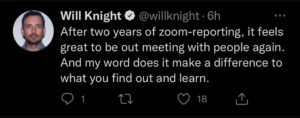As the world marches toward the “new normal,” more and more employees are trading in athleisure wear for business attire and boldly making their way back to the office. Many reporters have written extensively about news, issues and trends associated with the “return to work,” but less have talked about the fact that they too are making their way back to the office after a long hiatus.
For PR professionals, the media’s return to the office has many ramifications… we must start to factor reporters’ commutes into the timing of our pitches, dig up office lines in place of mobile numbers, and – perhaps most importantly – revisit the possibility for media tours.
What is a Media Tour?
For those who are unfamiliar, a media tour is a series of meetings between a company spokesperson and relevant reporters based in a specific area – often media-centric cities like NYC, San Francisco and Washington D.C.
The goals of a media tour can vary, but generally, they serve as opportunities to:
- Get a company and its leaders on the radar of relevant reporters,
- Instill excitement about a company’s vision, momentum and growth,
- Lend perspective on industry issues and trends, and
- Forge personal connections between reporters and company spokespeople (as well as the PR professionals who represent them).
The Value of Media Tours
While there are certainly instances when a media tour results in near-term stories – especially when timed with major company news, which we recommend – the value of these meetings is often much greater than an immediate hit.
Holding in-person meetings with reporters allows reporters to “go deep” on a company and an industry, in ways that can be challenging by phone or even via Zoom. Journalists have more time to ask clarifying questions and pick up on subtleties that don’t always translate over digital channels. Just ask Will Knight, senior AI writer at WIRED, who recently tweeted:

More than digging into company and industry-related topics, small talk at the start or end of a meeting can inspire story ideas or serve to offer a spokesperson’s perspective on a trending, though not necessarily a company or industry-related, issue. For instance, maybe an offhand comment about the CEO’s journey to the media office could inspire a story about executive travel quirks.
Lastly, in-person meetings are great ways for reporters to get to know the character and personalities of company leaders. Having this more personal understanding of an executive can help drive speaking engagements at media-sponsored events, land leadership profiles or simply tease factoids about the humans behind the world’s most intriguing businesses.
For instance, following what ended up being the last media tour I staffed pre-COVID, I had the chance to introduce V2 client Daniel Dines, CEO/Founder of UiPath, to Alan Murray, CEO of Fortune Media. While they discussed the Robotic Process Automation market that UiPath leads for most of the meeting, they also spent a great deal of time talking about their shared passion for reading. This conversation resulted in next-day coverage in Alan’s CEO Daily Newsletter, which – in addition to including details about UiPath’s business – offered this personal tidbit about Daniel:
Dines told me his “passion in life” is reading fiction. Kafka is his “all-time favorite.” More recently, he enjoyed A Gentleman in Moscow, which I would recommend as well.
Fortune followers had an even greater opportunity to get to know the chief executive of UiPath when Alan later interviewed Daniel for his Leadership Next podcast (check it out here), which also resulted from this in-person introduction.
Kicking Off a Media Tour Today
While many reporters are expressing renewed interest in in-person meetings, it’s still best practice to gauge comfort levels and circumstances under which journalists will consider a face-to-face interview with a company spokesperson. If they ARE open to it, consider what “hooks” they’ll need to accept an interview offer (even though reporters may be open to in-person meetings, they are still extremely busy and need to know that this will be time well-spent).
To that end,
- Consider timing media tours with major company or industry news (e.g., on the heels of significant funding, in advance of major survey findings that can be offered under embargo)
- Explain why the executive is one to know, playing up their company’s exceptional growth, valuation and/or vision to radically disrupt the status quo
- Reference the reporters’ recent focus areas and how the spokesperson can offer perspective on the issues and trends they are writing about
With these tips, you should be well equipped to pack your bags and make your way (back) to media offices. Long live the media tour!